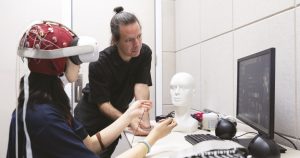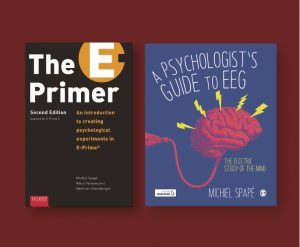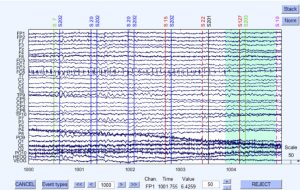Imagine being paralysed from the neck down and unable to move or speak—yet still fully capable of thought. Today’s brain-computer interfaces (BCIs) can translate specific mental commands, such as ‘move my right finger’, into actions, allowing patients to control robotic limbs or type messages using only their thoughts. But what if we could bypass these mental steps entirely?
This is the focus of the cutting-edge research of Michiel Spapé, associate professor in the Centre for Cognitive and Brain Sciences (CCBS) at the University of Macau (UM). Unlike traditional BCIs, which require users to mentally simulate step-by-step movements, Prof Spapé’s team investigates how the brain encodes motivations—for example, the desire to drink from a cup—without focusing on the muscle movements needed to accomplish the task. Their work holds the potential to create a future where even healthy individuals can control technology effortlessly through pure intention, blurring the line between mind and machine.
Tackling the Fundamental Challenges in BCI Technology
Prof Spapé has long been driven by a profound question: How can we translate subjective human consciousness into a form that machines can understand? Current BCI technology works by detecting electrical signals generated by brain activity and converting them into commands that computers can interpret, enabling the brain to control external devices. However, despite these advancements, the technology often feels unnatural in real-world use.
Prof Spapé uses a simple example to explain this challenge. When we pick up a teacup, our brain naturally and effortlessly generates a smooth sequence of motor commands, much like breathing. Existing BCI systems, however, require users to break this action into a series of deliberate mental steps. To lift a teacup, a person must first imagine raising their arm, then moving it forward, and finally gripping the handle with precise finger movements. This rigid, step-by-step process makes interactions feel awkward and counterintuitive. Prof Spapé asks: ‘How can we make these commands as natural as breathing, without requiring conscious effort?’ In CCBS, he is leading his team to answer this question. They are dedicated to overcoming this bottleneck by creating BCIs that enable seamless and intuitive interactions between the brain and external devices.
Through relentless effort, Prof Spapé’s team has developed a bidirectional BCI system powered by neuroadaptive modelling. This advanced technology uses real-time brain activity analysis to determine ongoing motivations and emotions, and uses this information to perform actions or higher-level interactions. For example, by integrating the learning and training capabilities of generative AI, the system can interpret how we respond intuitively to different stimuli, allowing for far more advanced brain control than simply movements.
A notable application of this technology is the ‘AI Tutor’ system, which Prof Spapé’s team is currently developing. This system combines neuroadaptive modelling with multimodal emotional AI, and features a Deepseek-based artificial agent that acts as a tutor. The AI Tutor assesses students’ emotional states by analysing their micro facial expressions, speech prosody, and real-time electroencephalography (EEG) data. Using this information, it can control teaching strategies to better suit individual learners. Specifically, the AI Tutor identifies emotional indicators that are essential for motivation and learning, including frustration intensity, attentional engagement, and moments of sudden insight. For example, if the system detects a student’s frustration with the learning materials or a decline in interest, it signals the need to adjust teaching strategies, such as by simplifying the material or repeating key concepts. This technology has the potential to significantly enhance learning effectiveness, particularly in distance learning scenarios and during study sessions.
‘It’s like the difference between a choreographed routine and an improvised dance,’ explains Prof Spapé. ‘Current BCIs force the brain to follow pre-set commands, whereas we’re developing technology that enables genuine neural dialogue—where both systems adapt to each other in real time.’
Capturing the Brain’s ‘First-Person Experience’
A central focus of Prof Spapé’s research involves advancing BCI systems beyond simple movement decoding to capturing the motivational dimension of actions—what a person truly desires and how it feels to perform an action. This work builds on a fundamental insight from cognitive science: natural behaviour emerges from integrated perception-action-emotion loops, not just isolated motor commands. Traditional BCIs often treat the brain as a ‘biological remote control’, translating neural signals into one-way commands, such as ‘move robotic arm to cup’. However, such systems fail to capture the first-person experience—the emotional feedback that shapes intentions, like the urge to withdraw from a hot cup or the satisfaction of a firm grip. Prof Spapé’s approach prioritises decoding these affective states to create BCIs that understand not just what someone is doing, but why they want to do it, closing the loop between desire, action, and emotional consequence.
To truly replicate the cycle, Prof Spapé emphasises that BCI technology must advance beyond its current paradigm. Next-generation BCIs must not only decode motor commands but also capture the brain’s first-person experience—the subjective sensations and perceptions that form the foundation of human consciousness. Achieving this requires neurophenomenology decoding, which links neural activity to subjective experiences such as the vividness of seeing the colour red, the sharp sting of a pinprick, and the nostalgic memory evoked by the smell of coffee.
Prof Spapé explains the complexity of this challenge: ‘Imagine trying to describe the colour red to someone born blind. You can outline its wavelengths and associations, but you can never truly convey the experience of seeing red.’ This highlights the irreplaceable nature of first-person experience and poses a fundamental challenge in consciousness science: how to bridge the explanatory gap between subjective phenomenology (what it feels like) and objective neurobiology (what physically occurs) to truly understand how consciousness emerges from neural processes. To tackle this issue, Prof Spapé and his team are conducting experiments to translate subjective first-person experiences into quantifiable data. By correlating these experiences with brain activity, they aim to identify the neural mechanisms responsible for generating specific conscious experiences.
Injecting New Momentum into Neuroscience Research
Prof Spapé joined UM in 2023 as an associate professor at the Centre for Cognitive and Brain Sciences. Along with bringing cutting-edge perspectives to brain science research, his unique interdisciplinary background has also infused innovative momentum into the UM master’s programme in cognitive neuroscience, where he integrates his expertise in cognitive psychology, neurotechnology, and computer science.
Prof Spapé’s multidisciplinary expertise comes from an insatiable intellectual curiosity and a determination to push beyond traditional academic boundaries. Originally specialising in cognitive psychology, he quickly became captivated by the deeper complexities of the human mind. Reflecting on his educational journey, he shares, ‘I started as just a psychology student fascinated by the human mind. But during my PhD at Leiden University in the Netherlands, the first time I saw and understood EEG brainwaves—those messy, jiggly lines—it felt like the brain was whispering its secrets to me.’
This revelation reshaped Prof Spapé’s academic journey and deepened his commitment to neuroscience. After completing his studies at Leiden University, he pursued postdoctoral research at the University of Nottingham in the UK, where he focused on the electrophysiology of motor control. There, he delved into signal processing and immersed himself in the world of neurons and circuits. He then spent four years at the Helsinki Institute for Information Technology in Finland, studying computer-mediated touch while collaborating with leading experts in computer science. However, along the way, Prof Spapé had a profound realisation. ‘At heart, I’ve always been a psychologist. I want to understand how the mind works, not just the brain,’ he reflects. ‘That’s why I eventually returned to psychology departments, first in Liverpool and later in Helsinki. To me, neuroscience and computer science are critical tools to uncover the mysteries of the mind. But to make a global impact, there needs to be an equal partnership between psychology and technology.’
Throughout his career, Prof Spapé has been dedicated to interdisciplinary collaboration, working closely with computer scientists and engineers to achieve research breakthroughs. Now at UM, he leverages his European academic network to broaden students’ international research perspectives. One of his initiatives—which he humorously refers to as his ‘spy-vs-spy operation’—involves arranging regular online meetings between his students and their counterparts in Helsinki, fostering meaningful cross-border collaboration.
‘It’s about keeping communication channels open,’ Prof Spapé explains. ‘At the very least, students learn how research works in other countries and improve their English communication skills. But more often, these exchanges spark new ideas and lead to collaborative projects. Just last month, we held a productive online session with Finnish scholars to optimise some joint research initiatives.’
Making Technology an Extension of the Body
Prof Spapé and his team are working to translate the brain’s subjective consciousness into controllable actions. More specifically, their work focuses on teaching machines to truly understand the nuances of tactile feedback. ‘This foundational research will open up new possibilities for human-machine interaction and has game-changing implications for the future of smart prosthetic limbs and remote collaboration,’ Prof Spapé explains. ‘Perhaps in the near future, technology will no longer feel like a separate, external device, but instead function as a natural extension of the human body.’
Deciphering the brain’s consciousness to redefine brain-computer interaction is an extremely challenging pursuit. Inspired by the cognitive psychologist Prof Geoffrey Hinton, the 2024 Nobel laureate in physics, whom he deeply admires, Prof Spapé remains passionate about artificial neural networks and machine learning. He is committed to unravelling the mysteries of consciousness to fundamentally reshape the ways humans and machines interact. ‘I hope to leave my mark on this journey. Through groundbreaking discoveries, my goal is to establish the theoretical and technological foundations for a new era of human-machine symbiosis.’
About Prof Michiel Spapé
Michiel Spapé is an associate professor in the Centre for Cognitive and Brain Sciences and the Faculty of Science and Technology at the University of Macau. He obtained his PhD in psychology from Leiden University in the Netherlands and went on to conduct research on the brain and mind at the University of Nottingham in the UK, the Helsinki Institute for Information Technology in Finland, Liverpool Hope University in the UK, and the University of Helsinki in Finland. He has published 74 peer-reviewed articles, authored two textbooks, and holds a patent. Prof Spapé also serves as an associate editor of Psychological Research and Frontiers in Psychology: Cognition.
Text: Kelvin U
Photo: Hasen Cai, with some provided by the interviewee
English Translation: Kelvin U, Bess Che





